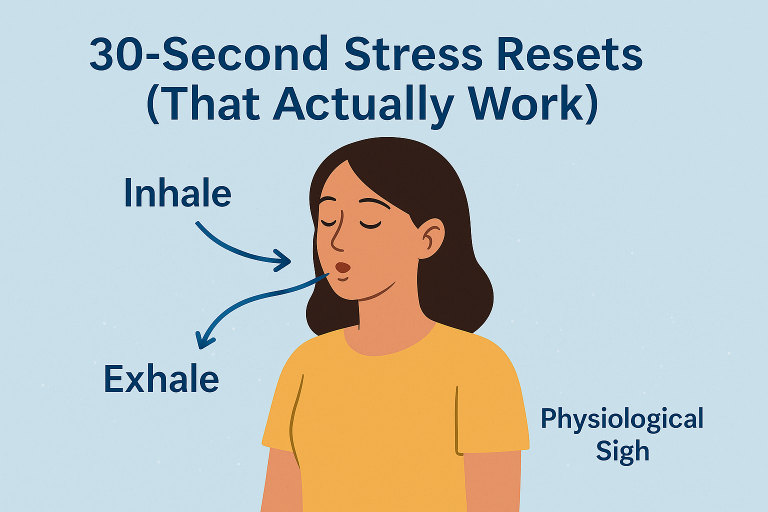We all know stress is unavoidable—but how you respond to it can make the difference between staying sharp and spiraling into burnout. The good news? You don’t need an hour-long meditation or a yoga retreat to calm down. Research shows that even 30-second interventions can reset your nervous system and lower stress in the moment.
Below are five science-backed “stress resets” you can do anywhere, anytime—whether you’re stuck in traffic, about to walk into a meeting, or winding down at night.
Why Quick Resets Work
Stress triggers the sympathetic nervous system—your fight-or-flight response. The key to calming down quickly is activating the parasympathetic nervous system, sometimes called the “rest and digest” mode. Techniques like controlled breathing, muscle relaxation, and grounding exercises all tap into this system.
According to research published in Frontiers in Psychology, short bursts of slow breathing improve heart rate variability (HRV), a marker of resilience to stress . Other studies show that even micro-meditations and progressive muscle relaxation can reduce anxiety in under a minute .
1. The Physiological Sigh (30 Seconds)
Popularized by Dr. Andrew Huberman and supported by respiratory physiology research, the “physiological sigh” is a rapid way to downshift your stress.
How to do it:
- Inhale deeply through your nose.
- Take a second, shorter inhale (topping off your lungs).
- Exhale slowly and fully through your mouth.
- Repeat 2–3 times (about 30 seconds).
Why it works: This double-inhale + slow exhale combination quickly reduces CO₂ levels and activates parasympathetic calming pathways.
2. 5-5-5 Box Breathing
Used by Navy SEALs to stay calm under pressure, box breathing is simple, structured, and surprisingly effective.
How to do it:
- Inhale for 5 seconds
- Hold for 5 seconds
- Exhale for 5 seconds
- Repeat for 3 cycles (≈30–45 seconds)
Why it works: Slow, deliberate breathing reduces stress hormone release and promotes focus. A study in BMC Complementary Medicine and Therapies showed that just one minute of slow breathing decreased self-reported stress levels.
3. Progressive Muscle Release
Stress often hides in your body as tension—tight shoulders, clenched jaw, hunched posture. This quick technique unclenches those stress “storage units.”
How to do it:
- Clench your fists tightly for 5 seconds.
- Release suddenly.
- Do the same with shoulders (shrug, then drop).
- Repeat once more.
Why it works: Progressive Muscle Relaxation (PMR) reduces physical tension and sends calming signals back to the brain. Even mini-versions like this are effective .
4. The 5-4-3-2-1 Grounding Drill
When stress pulls your thoughts into the future or past, grounding resets your mind to the present moment.
How to do it (takes about 30 seconds):
- Notice 5 things you see
- 4 things you feel (chair, clothes, floor, etc.)
- 3 things you hear
- 2 things you smell
- 1 thing you taste
Why it works: Grounding interrupts racing thoughts, helping reduce anxiety and improve focus. Widely used in cognitive behavioral therapy (CBT), it’s a favorite among psychologists for its speed and accessibility .
5. Gratitude Micro-Shift
It might sound soft, but research shows gratitude practices lower cortisol and improve resilience over time .
How to do it:
- Take 30 seconds to name (silently or out loud) one thing you’re genuinely grateful for.
- Visualize it clearly and notice how it feels.
Why it works: Gratitude activates reward pathways in the brain, counteracting the negative bias of stress. Even a single thought can change emotional state quickly.
When to Use These Resets
- Before a meeting or presentation: Try the physiological sigh for calm confidence.
- During work overload: Box breathing helps sustain focus.
- In bed with racing thoughts: Use the grounding drill or gratitude shift.
- After conflict or bad news: Muscle release helps shed physical tension.
Building the Habit
Quick resets are powerful, but they work best when you use them consistently. Try picking one technique per week and practice it daily—even when you’re not stressed. That way, your body “remembers” it under pressure.
Consider pairing them with triggers:
- Phone rings → do one physiological sigh
- Before opening your inbox → 5-5-5 breathing
- Sitting in traffic → 5-4-3-2-1 grounding
Over time, these small resets compound into a calmer, more resilient baseline.
Final Thoughts
Managing stress doesn’t always require long meditation sessions or lifestyle overhauls. Sometimes, all it takes is 30 seconds. Whether it’s a double inhale sigh, a structured breath, or a quick grounding drill, these mini-resets give you a way to regain control—anytime, anywhere.
So next time stress spikes, remember: your reset button is just half a minute away.




